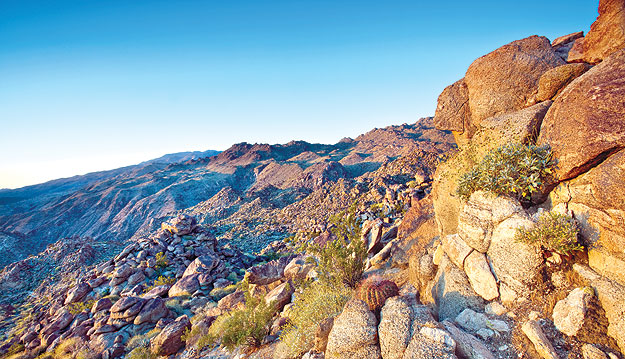
Wildflowers and cacti bloom along rocky trails while impressive vistas beckon. This is desert hiking in the springtime. These two trails offer excellent experiences for seasoned hikers, but there are more than 100 hikes in the greater Coachella Valley area. Check out our website or visit www.philipferrenti.com for trails serving all levels of expertise.
Lost Palms Oasis
Length: 8 miles
Difficulty: Moderate
Directions: Head east on I-10. Exit at the Joshua Tree National Park off-ramp, turn left on the road leading into the park, and drive eight miles to Cottonwood Visitor Center.
On the southernmost boundary of Joshua Tree National Park, several minor earthquake fault lines — branches of the San Andreas Fault line — cut through the low mountains overlooking Interstate 10. A large, lush growth of California fan palms, long admired for their stately beauty, come together to form Lost Palms Oasis — the result of water seeping to the surface through the fault. Explore this grouping of fan palms during a beautiful four-hour day hike through washes and over plateaus. Feast on stunning views of the surrounding mountains and valleys, including the distant San Jacinto Mountains to the west.
The trail begins east of the visitor’s center and heads immediately up a gradual rising slope. After passing through a series of washes, look for the brown trail markers. In spring, flowers and rich plant life entice you to stop and enjoy the flora. At the three-mile marker, you’ll come to a plateau. A southern gaze reveals vistas of the Salton Sea Basin — almost primeval in its rugged wilderness. A quick climb through several small washes leads to the overlook for Lost Palms Oasis. Drop down the indicated trail into the oasis or admire the beauty from above. With little elevation gain, it seems more like a walk through a nature park and provides an intimate feel for the mixture of rugged mountains and flowering desert found along this trail. Joshua Tree National Park, Twentynine Palms. Information: 760-367-5500
Art Smith Trail
Photo by Philip Ferranti
Art Smith Trail
Length: 16 miles
Difficulty: Strenuous
Directions: Take Highway 111 in Palm Desert to Highway 74. Park at the Santa Rosa & San Jacinto Mountains National Monument Visitor Center or across the street at the paved Art Smith trailhead parking lot.
This trek is a real treat for the hiker who enjoys a full day’s journey without excessive elevation gains. The Art Smith Trail serves as a major link between the Palm Desert portion of the Santa Rosa Mountains and Palm Canyon’s network of trails, including the Murray Peak area south of Cathedral City. This eight-hour hike (elevation gain 1,200 feet) allows you to penetrate the mountains while resting along the way in several palm oases that accent the trail.
Begin hiking after the Art Smith sign to the west of the parking lot. After several hundred yards, the trail will cut across the wash and pick up on the other side, climbing steeply up the mountainside. As the trail continues, stay left on the main trail, disregarding several side trails that veer off to the right. Beneath you is Bighorn Golf Club.
After more than one and a half miles, you will reach the top portion of the Art Smith Trail. Hike through several palm oases for the next two miles. During March and April, this section of the trail is abundant with plant life, barrel cacti, and other colorful wildflowers and cacti in bloom. As you continue, the cities along the valley floor are visible from the north. After almost five miles, the trail crosses the upper reaches of Magnesia Canyon, a palm-filled canyon that offers a welcome sheltered lunch stop. Explore the canyon before continuing to the western end of the trail at Dunn Road. Information: 760-833-7100
Lost Palm Oasis and Art Smith Trail hikes are adapted with permission of the publisher from Philip Ferranti’s book, “140 Great Hikes in and Near Palm Springs” (Big Earth Publishing). For more information, contact the author at 760-345-6234 or e-mail him at [email protected]. You can also visit www.philipferranti.com.
